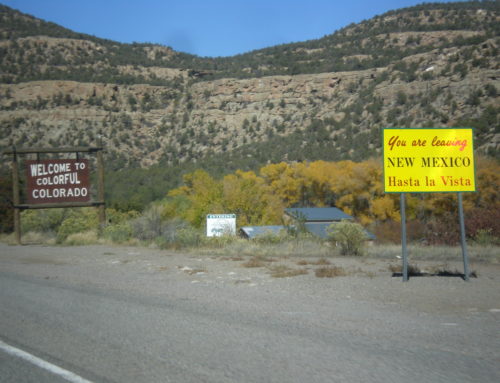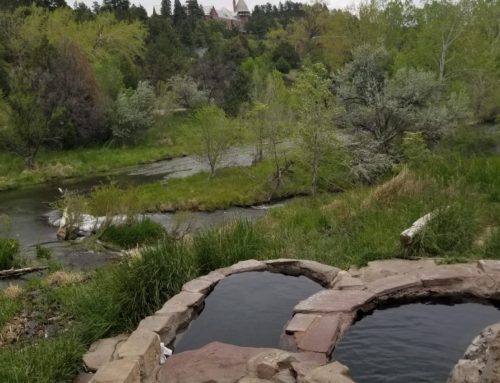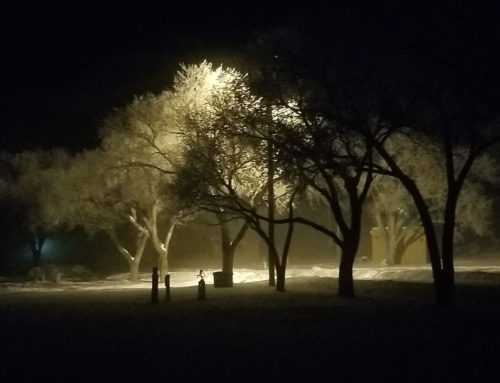“Ready to head into the Village and hit the library again – this is becoming a good routine. I did laundry yesterday at Basecamp and fished while my clothes were in the machines. I also figured out how to get Wi-Fi with my laptop (the antennae switch was turned off), so it was a good day. Hopefully, I’ll finish the lofts, workbench, desk and shelving in the shed today so I can start loading it with my material goods.”
-Journal entry: Wednesday; June 20, 2018: 9:18 am. In my camper, Cochise.
Public libraries have long served as an oasis of comfort for the dispossessed, a shelter in the storm for those without homes. The Red Feather Lakes Community Library serves that purpose to the campers, trampers and other transient vagabonds, as well as the hearty residents of this magical mountain village.
For me, it’s where I can get the internet (24/7 Wi-Fi that includes the parking lot), cell phone service (4G!) and enjoy the modern amenities of a clean, well-lighted place – and plumbing fixtures.
It’s also the hub of the community, being open 7 days a week (except major holidays) year-round. It caters to all ages, especially kids. It has a large children’s area inside (behind double glass doors, so they can be seen and not heard) and an educational playground outside that has hoof and paw prints in the sidewalk depicting the sign left by moose, bear, mountain lions and other indigenous critters so local youngsters begin to realize how to recognize their unseen neighbors. Not a bad idea for the preservation of the herd – as in ours, the humans.
But even in magical mountain communities, bad things can happen. And sometimes they do. At 6 am on Saturday, June 9, 2012, a call came to a Rist Canyon volunteer firefighter regarding smoke sighted near an area known as Paradise Park, not far from Red Feather on the other side of the Poudre River. He found a small, smoldering fire most likely started by lightning. Colorado was experiencing a bad drought season and there were already several wildfires that had burned in the region, so the firefighter called for a full crew to respond and try to extinguish any problem before it got out of hand.
Nearly two decades of pine beetle infestation and destruction left a lot of dead standing timber, and the dry vegetation quickly traveled into the trees. By the time the crew arrived the fire had engaged the landscape and was heading through the canyon with lightning-borne speed – estimated at 20-40 feet per minute. By mid-morning dozens of firefighters, several helicopters and two air tankers were on the scene and into battle, trying to defend structures and cut fire lines – but the flames would not be deterred. Winds picked up and by noon a thick grey plume of smoke was towering into the sky, filling the western horizon and blocking out the sun. It appeared as though to many of us Armageddon had just begun.
The smoldering fire had become an exploding conflagration, and Larimer County Sheriff’s deputies raced flames to evacuate residents in the winding mountain roads as power lines fell, communication relays failed and a local radio station went off the air. Evacuation orders go out, roads are closed and larger firefighting agencies are brought in. Again, the flames are undeterred and escalate ferociously over the weekend. On Monday the fire is upgraded to Type 1 and management is turned over to the federal authorities. More aircraft and hotshot crews are immediately called in, along with other regional resources, but the fire engulfs 37,000 acres now and is totally uncontained.
Red Feather residents are eating the smoke but watch from what was then a safe distance. They gather at the library, across the dirt street from their own volunteer fire station, and wait for the latest reports. The reports are not good. Structures are being lost despite heroic attempts by firefighters to defend them. Just too much dead timber, dry grass and relentless wind sending walls of flames running up and down canyons and over mountains. It gets worse, and worse, for days on end. By Wednesday there are a thousand firefighters and 22 aircraft battling the blaze and they are able to keep the edge heading toward Fort Collins contained.
It looks and sounds like a battlefield as the heavy tankers rumble overhead, Chinook and Blackhawk helicopters pulling water out of Horsetooth and other reservoirs with flexible “Bambi Buckets” hanging from a long cable, their heavy rotors chop-chop-chopping through the acrid, brown air. Small, fixed wing aircraft dodge through the airspace, relaying vital information on the fire face’s movements to the incident commander below.
The National Guard is called out and deployed to keep the roadblocks staffed, as nervous locals and nosy “looky-loos” clog the few roads going into the war zone. More evacuation orders are issued and Red Feather Lakes Road (the only road from the lower region) is one way only, going down the mountain and jammed with evacuees and horse trailers. The Village of Red Feather Lakes is virtually cut off from the world, with limited communication or power. Again, the community gathers at the library, eager for news of the fire’s strength and direction. The news isn’t good.
On Thursday, the neighboring subdivision of Glacier View begins mandatory evacuation after a spot fire jumps the Poudre River and begins racing up the canyons and mountains toward the Village. Nearly 50 homes in its path are quickly consumed. Governor John Hickenlooper issues a state-wide ban on all open fires and fireworks.
The Mishawaka Amphitheatre (aka “The Mish”) is located on the Poudre and known to CSU students, locals and visiting explorers as an amazing musical venue to catch an indoor/outdoor show, as well as a legendary eatery for grabbing a beer and burger during the day and watching the rafters and kayakers run the rapids from the back patio – which extends over the water. Its large timber structure would go quickly in the flames.
Fortunately, or perhaps willfully, firefighters use it as a base of operations and position engines and other equipment in its parking lots and surrounding flat areas, drawing water from the Poudre and keeping the flames at bay. You gotta love those firefighters, and those of us who live in the mountains do so with all we have that we hold dear – because that’s what they risk their lives to protect, bivouacking in spike camps and working to exhaustion in unimaginable conditions.
I went through Wildland Firefighter classes given by the Larimer County Sherriff’s Office back in the late 1980s and passed after completing the challenging coursework and physical test of running 1 ½ miles in Nomex fireproof clothing, work boots and gloves within 12 minutes, which would be sufficient to get you out of trouble in most cases. I received my certification card (then pink, now red) and I was a “Yellow Jacket” (which referred to the yellow Nomex shirt). A Hotshot. We watched film (video?) footage of firefighters racing to save the iconic Yellowstone Lodge in that historical fire of 1988, flames leaping all around them and overhead, creating a canopy of whip cracking flames. It was an inferno. But the firefighters were successful, and I visited the lodge several years later. It is a marvel, and would be near-impossible to replace.
You really do gotta love firefighters. They put their lives in the hands of a greater power deliberately, and don’t always make it out. In 1994, the Storm King fire outside of Glenwood Springs, Colorado, caught 14 Yellow Jackets in a saddle (low spot between hills) and overran them, not quite quickly enough. They deployed their emergency shelter blankets, standing on one end to hold it in place before dropping quickly to their knees and falling forward, pulling it overhead and tight, then scratching a hole in the dirt to breath out of; but the aluminized cloth elastic-rimmed wraps are meant to protect you if a fire flashes over you in a matter of seconds. This fire lingered, and they all perished when their oxygen ran out and heat overtook them. I cried when I first heard that, and if the truth be known, I have tears in my eyes as I write this. Rest In Peace, brave Yellow Jackets, and may you spend your eternity in cool breezes and fresh air. I mean that with all my heart.
When the fire was finally 100 per-cent contained on June 30th, three weeks after it started, it had burned over 87,000 acres (more than 136 square miles), destroying at least 259 homes and killing a 62-year-old woman who was not able to escape quickly enough.
At the time it was the most destructive fire in Colorado’s history based on structures lost, and the second largest in terms of area burned. That unwanted distinction was short-lived, however, when the Waldo Canyon Fire outside of Colorado Springs, which started one week before the High Park Fire was contained, consumed 346 homes. The following summer, the Black Forest Fire, also outside of Colorado Springs, became the most destructive fire in state history when it destroyed 488 homes, leaving 37 more partially damaged and killing two people, a husband and wife in their early 50s whose bodies were found in what had been their garage, next to their car whose doors were open and trunk packed with belongings.
Lightning was quickly ruled out as the cause of the Black Forest Fire, and it was eventually determined to have come from a homeowner who was doing some remodeling and burning scrap wood in a fireplace and woodstove. There were no spark arrestors on the chimney flues. The temperature was 97 degrees, the vegetation was tinder-dry, and winds were blowing at 37 mph. Lightning is completely unmanageable by nature. The stupidity and carelessness of our fellow human beings can be equally unimaginable, by default. But, I digress… Arrrgggghhhhh!!!!
Back to the Village, which had been spared the flames by a matter of miles. The roads re-opened, power and communication lines were re-strung, and things finished out in 2012 without further incident. A sense of normalcy returned. But danger came with it.
As is all too often the case in the West, flash floods follow wildfires. Mountainsides and canyonlands are denuded of soil holding trees and vegetation. Fire burns moisture and nutrients out of the earth surface, turning it to nasty ash which quickly turns to a deadly mudslide in the event of heavy rainfall. The residents of the area and Larimer County officials knew this and prepared aggressively by upgrading culverts to larger, concrete structures designed to not clog up with debris. Other flood mitigation precautions were implemented and everyone kept their fingers crossed that we wouldn’t end the drought too severely, but Mother Nature can have a wicked sense of humor. You gotta be fearful of Mother Nature.
In September of the following year, 2013, she let loose with 15” of rain in a matter of days all along the Front Range of the Rockies, which is equal to the average annual precipitation for the state (including snow). The areas west of Colorado Springs suffered worst of all, following the two monster wildfires of the previous summers. Cars were literally floating away in rivers of ash and mud on the streets of Manitou Springs and throughout the canyons.
Larimer County fared better, largely due to the preparations that had been undertaken, but power and communication lines again were wiped out, and Buckhorn Canyon Road, one of the primary roads used by firefighters assaulting the High Park Fire, was in many places completely washed away. I’ve fished the Buckhorn Creek for over thirty years, and normally in September there isn’t enough water to hold the little brookies who thrive there in the springtime flow of the snowmelt runoff. Most often the creek is narrow enough to jump across without splashing water and spooking the fish – unless your dog decides it’s a good spot to take a soak. You gotta love those dogs. But, again…
So, Mother Nature reminded us all who’s boss, and once more the Village was largely cut-off from the rest of the world. Living in the mountains can be often insecure. The rest of the time, which is by far most of the time, it’s like no other place imaginable. Almost a different world. The risk of nature’s wrath is a matter of choice – and preparedness. So, the inhabitants of the area chose to prepare.
The residents of the three communities who live along and are dependent upon County Road 74E (Red Feather Lakes Road) are: Glacier View (badly damaged by the fire), Crystal Lakes (where I live in this camper with my dog during the summer), and – of course – the Village of Red Feather Lakes, where we all gather to bond and sing silly little mountain tunes (alright, we don’t really sing, but anyway). Each community has its own volunteer fire department and a jurisdictional district of service. Since there is no legal, municipal structure to any of these communities (which is why most of us live there) everything is done by choice and voluntary contribution.
However, a majority of the local denizens realize that it’s in their vested interest to protect their livelihood, property and hard-sought or easily-inherited little slice of mountain paradise. The others, a minority, seldom come out of the woods and rarely bathe, shunning society and hunting various rodents with their putrid breath (alright, I’m being a little silly now. I get that way when I feel I might actually wrap up another one of these blog post thingies).
To the point, the North 40 Mountain Alliance was formed as a non-profit cooperative of volunteers from the aforementioned three communities and fire districts. It’s mission, as stated on its website, begins: “The North 40 Mountain Alliance (N40MA) is a local group dedicated to being prepared for and resilient in case of wildfire and other emergencies.” They utilize the fire district’s communication and information gathering systems, amateur radio emergency services, assigned Neighborhood Captains using phone tree networks and other resources to coordinate with the Incident Commanders of the firefighting agencies along with local, state and national emergency service providers (including FEMA and the Red Cross). Their primary purpose is to provide the most accurate and up-to-the-minute information (because disaster evacuation is a matter of minutes) when danger strikes, and they help rebuild the communities in the aftermath. It’s a great thing to have. Takes a little uncertainty out of living in the mountains. Let’s you focus on other things. Like fishing. And singing silly little mountain tunes while bonding with your neighbors.
Of course, there needs to be a place where folks can go for this vital, potentially life-saving information, and it can’t be the fire station. Firefighters don’t need hundreds of people huddled around the building blocking the exit routes and asking questions when disaster strikes – and they’re going to be blasting out of there anyway. Let’s don’t forget, they’re the ones who run into the fire danger when the rest of us are running away from it. That’s what they do. And in this case, voluntarily. Please keep that in mind if you ever meet a firefighter, or if you know one.
So, each fire district designated a place for its residents to go, called Community Hubs. Guess where the hub is in Red Feather? I’ll give you a hint: It’s the library. Where else would it be? That was a silly question, but…well, you know…
Why am I going on with all this stuff about the Red Feather Lakes Community Library? That’s a good question. The answer is, I just really like libraries, for one thing, and I love my new community of mountain folk in and around the Village. You appreciate your neighbors much more when you’re dependent upon them in the event of emergencies, which is the case in rural and mountain areas. It’s also a big part of the appeal, to me anyway, in actually having an opportunity and need to interact with others of the herd – our herd, the humans – instead of staring at some silly little electronic device exchanging “selfies”, images of food or sharing other people’s posts (but that’s just because I’m an old phart and didn’t grow up that way, otherwise I’m sure that I’d be doing it all the time. Well, maybe…)
And finally, yes I think we’re coming to a close here, there’s one last bit of news in case you’re wondering how all this information gets transmitted and the library is able to function during an emergency situation when power lines are often the first to go in a fire or flood (and sometimes the cause of the fire in high wind situations). Well, you’ll be happy to know that the Red Feather Lakes Community Library was recently awarded a $100K grant to install photovoltaic solar panels so the Community Hub can function off-grid during such power outages. Gotta love those community supporting grants, and the great work that can be achieved with the funds. Please keep that in mind if you ever meet someone who works for non-profits and foundations, or if you know one. They’re like firefighters that way. Deserving of our gratitude.
Well, I’ll leave it at that. I don’t want to get preachy because I’m no one to preach. I’m just a humble storyteller, and I haven’t eaten yet today. I’m feeling a little dizzy and lightheaded. Reminds me of the 70s kind of…
Thank you for your patience if you’re still here, and I hope you got something from all this. Let me know what you think if you feel so inclined. I seldom get to communicate with my fellow herd members because I live with a dog in a camper in places where I don’t know anyone, until I’ve been there a while. Then I move, because after a while it’s either getting too hot or too cold. Again, I’m an old phart. But, that’s the life of a rubber tramp and – just between you and me, dear reader – I wouldn’t have it any other way.





